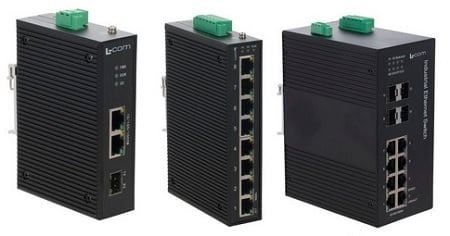What You Need to Know: Unmanaged Switches for Industrial Ethernet
Network switches allow the interconnection of devices and controllers across a facility, with particular features that make them a good fit for industrial applications. We introduce a few of the leading manufacturers of these products.
Network switches are one of the most fundamental level devices of network architecture, allowing the interconnection of floor-level control and output devices. Often, these network switches will act as a link between gateway adapters for other protocols and the main process controller.
A few features make an industrial network switch stand out from a commercial or home-use device. Often they are built with extra rugged IP ratings to withstand hard environments, they can be mounted to DIN rails inside enclosures, and they have redundant power supplies for industrial voltages. Many are also often equipped with power over Ethernet (PoE) and M12 end connectors for many of today’s industrial end-use demands.

Figure 1. The network switch, hub of network activity at the controller and device level of an industrial network. Image used courtesy of Canva
From a cost perspective, you can expect to spend well over $100 for even the smallest high-quality industrial Ethernet (often abbreviated IE) switch. For extra features and a higher quantity of ports, costs will be much higher from there. Do not cut corners when sourcing an Ethernet switch. If this device fails, it will create downtime for many pieces of equipment, and troubleshooting network technology is a less common skill among industrial specialties.
Many less expensive switches are available from online and box store distributors, which work well sitting on a living room shelf, but are not designed for long-term application in a control cabinet. I have used many such small 5-port switches from a spare box of parts, and although they performed perfectly for a test bench setup, I would not recommend them for use in an environment for which they were never designed.
For an integrator or an end customer, there are a few considerations that must be weighed to make the proper selection.
Critical Product Selection Questions
Most manufacturers offer a wide array of models to fit nearly every situation, so you must be prepared to answer a few important questions about your own system
How many ports are required?
Models range from 4 to over 20 ports. Most of the smallest models commonly have 5 ports—perfect for a small machine center with a PLC, HMI, 1-2 VFDs, and a connection to a separate gateway or parallel machine center.
What is your power supply?
Both DC (12 to 48 volts) and AC (24 to 120 volts) inputs are often available. Most standard general purpose switches require a 120 VAC outlet nearby, which can be inconvenient in a control cabinet.
What speed is required?
10/100 Mbps (fast Ethernet) and 1000 Mbps (gigabit Ethernet) are common requirements. Most modern industrial controllers are constructed with a 10/100 Mbps standard.
What connection interface do you need?
Fiber optic for long distances, RJ45 for standard general-purpose, or M12 for weatherproof connections on a machine. Industrial applications are a unique setting for the 5-pin M12 connectors.
What operating temperatures will you face?
A few degrees of product tolerance can make a major difference in system operation. Some switches will have an ‘extended operating temperature’ rating which, obviously, is beneficial in extreme environments.
Power over Ethernet (PoE)?
Not only is PoE a common requirement, but you must also consider the power output capability, often noted as PoE, PoE+, and PoE++. These ports provide from 15 W to 90 W of power depending on PoE standard class.
Do you use other communication protocols?
Ethernet TCP/IP is the baseline standard for switches, but many are compatible with PROFINET and Modbus TCP, among others. Be aware that some networks require gateway adapters to bridge between Ethernet and the device-level protocol.
Where will it be mounted?
The power connectors are located in various places around the switch, including top, sides, and front. The height, width, mounting style, and fan designs must also be considered when positioning the device on a DIN rail inside the enclosure.
Should you purchase from the same manufacturer as your control equipment?
Many manufacturers will provide extra features that improve performance when used with their own control equipment, and this can be well worth the cost.
Managed or unmanaged?
A managed switch can provide extra features for an additional cost, but usually requires configuration and IT knowledge to properly use. This article addresses only unmanaged switch suppliers, as noted below.
Who Makes Industrial Ethernet Switches?
The following list highlights the product lines for a few manufacturers of unmanaged switches, which do not provide some advanced functions such as adjusting specific port settings, port statistics and data analysis, and security restrictions for individual port connections. Compiling all makes and models of network switches into a single list would not be very useful. Most manufacturers provide both types of switches.
Rockwell (Allen-Bradley)
Stratix 2000

Siemens
SCALANCE X-000 and X-100 Series

Cisco
IE3000 Series

Moxa
EDS, MDS, and TN-Series

Phoenix Contact
FL 1000 Series

Advantech
EKI-2000 Series

Murrelektronik
Xelity Series

Stride
SE and SE2 Series
Antaira
LNX Series

L-Com
IES-MCG and IES-2000 Series
(All images used courtesy of the respective manufacturer)
This product roundup list outlines many of the manufacturers that offer product lines to fit the bill. This list intentionally avoids rating by order of top products, as each has specific advantages for certain situations. It is, however, intended to provide a starting point for research to weigh your needs versus the cost—costs which may not be available without a specific quote from a vendor or manufacturer.
We invite you to add your own feedback to this list, and if you are a manufacturer of this type of product and wish to be added, please simply reach out to ‘[email protected]’. We are happy to add quality products to compare, and as the landscape of technology evolves, we are always excited to learn about new manufacturers to add to the list.








